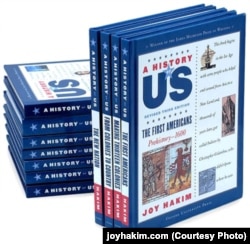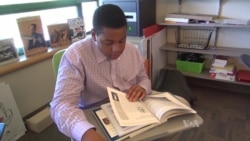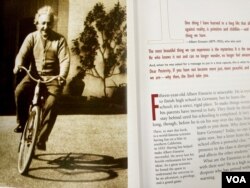A good journalist becomes good by learning to weave complicated ideas and simple facts into a compelling narrative that can inform, sometimes without the reader even knowing it's happening.
Joy Hakim is a good journalist, and that's why she decided to write textbooks.
Textbooks! Only the words "Pop Quiz" strike more dread into a student's heart. They are those thick, often boring, dusty tomes that students must slog through during class and for homework. They are almost universally despised for their ability to make even the most interesting topics read like a legal contract.
But the thing is, there is compelling stuff in those bulky science and history books. Ideas that can spark careers and dreams.
And that's what Hakim wants to get at.
Three decades ago, a newspaper asked her to cover a meeting about the poor quality of school textbooks. “I left that meeting astonished by what I had seen," she said. "And I thought, 'Oh, I can take a year and write a U.S. history. No big deal.' It took ten years from the time I started until I actually had a book in hand. And I expected it to be one book. It never occurred to me it would end up ten books.”
This isn't boring!
But it did, and the kids love them.
In one history class at Graland Country Day School in Denver, students are reading one book from Hakim's "A History of Us" series to guide discussions on the Civil War.
"It’s a page turner for sure," says seventh grader Ryan Gaghen. "You don’t realize how much you’re actually learning because it keeps you engaged.”
“It makes me actually want to keep reading instead of saying, 'Oh my gosh, this is over. Thank God!' as I do in other textbooks,” says William Forbes, another student.
WATCH: A History of US in school
How did Hakim do it? First, she avoided typical publishing protocol, which calls for a collaborate committee of writers; she decided her books would have a greater impact if she was the one and only author.
“When you think of the books that you like, the literary books ... it’s an author talking to the reader," she says. "Especially somebody who has some passion. I really care about what I’m writing.”
The second rule: everyone needs an editor. So, Hakim recruited world-class subject experts — plus a highly specialized team of product testers. “I actually paid children to be my editors," she says with a laugh. "And then I gave them a code. When you read this manuscript, put in the margin B for boring, G for good, NC for not clear.”
Teaching by telling stories
Most importantly, Hakim says she focused on the time-honored tradition of explaining through stories. Her series has now sold millions of copies and been honored with teacher and parent’s choice awards. So have her science books, including one that starts like this:
Fifteen year old Albert Einstein is miserable. He is trying to finish high school in Germany, but he hates the school, it’s a strict, rigid place. To make things worse, his parents have moved to Italy. They think he should stay behind until his schooling is completed.
Young Einstein gets expelled, and no one today knows exactly why. But Hakim continues the story: ...a letter from the school provides a powerful clue. ‘Your presence in the class is disruptive and affects the other students.’
Now who can't relate to that, at some point or another during their education?
Of course, this story has a happy ending: Einstein becomes one of the world’s leading scientists. It’s a theme — that kids don’t have to give up despite setbacks — that appeals to Josiah Davis, another young student of history.
“My favorite story was in [the Civil War book] War, Terrible War, which took place in 1855 to 1865," he says. "It was Chapter Seven, [the part] about Abraham Lincoln and how he went from a country boy basically to a president, and so it’s sort of inspiring to see how someone really small in the world can do something really big.”
Inspiring students to do something big is why history teacher Beth Gaffga uses Hakim’s books for class discussions. She says one of her favorite sentences in the series describes the Reconstruction period after the Civil War as, "hopeless, hopeful times." Talking with Hakim, she says she keeps that phrase on her whiteboard while students learn about the period.
“I have them make predictions," Gaffga says. "What’s going to be hopeless about it. What might be hopeful. And what’s awful and what’s noble. Your sentences make us think, is what I like.”
Hakim is now writing a new series about evolution and biology.
She says it’s challenging to find publishers for the alternative textbooks she writes, but she’ll keep trying for the sake of children and stories that help people think.
Her books are available on Amazon.com and Barnes and Noble websites, and you can learn more about Hakim at her website www.joyhakim.com.










